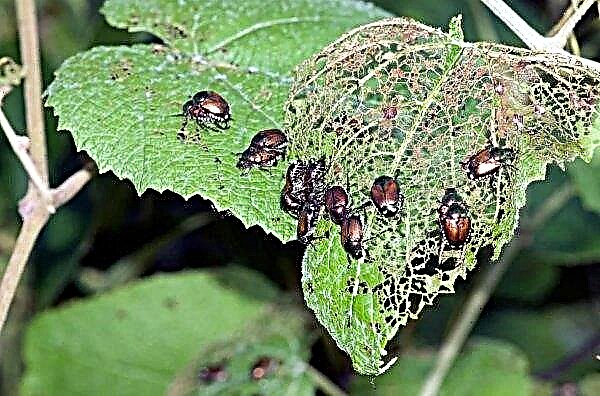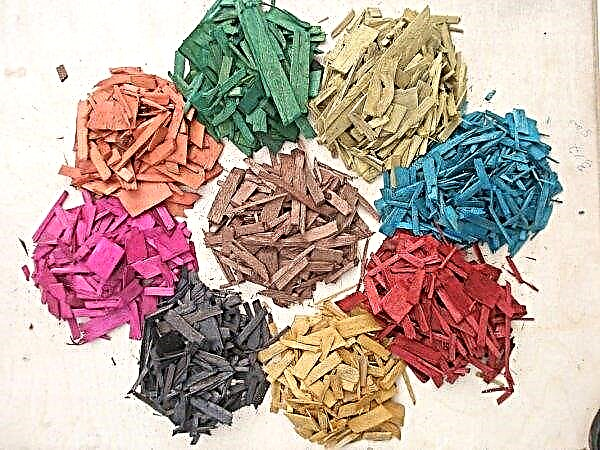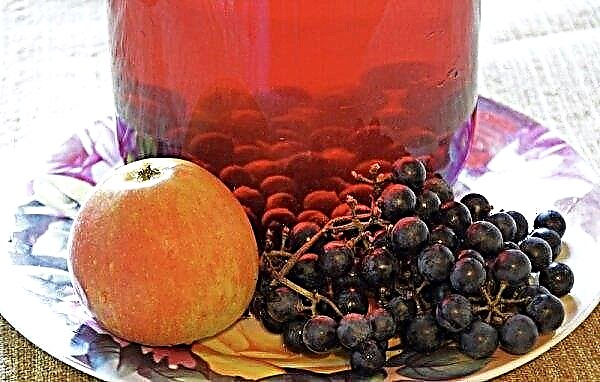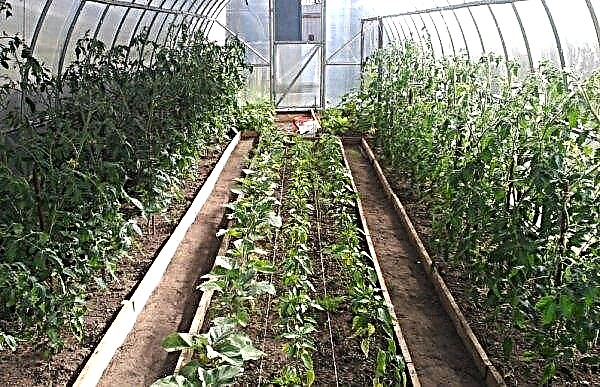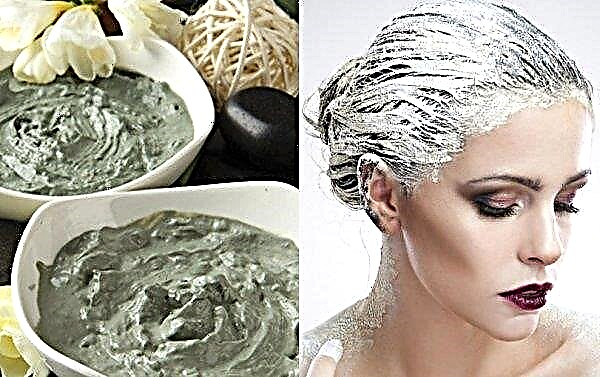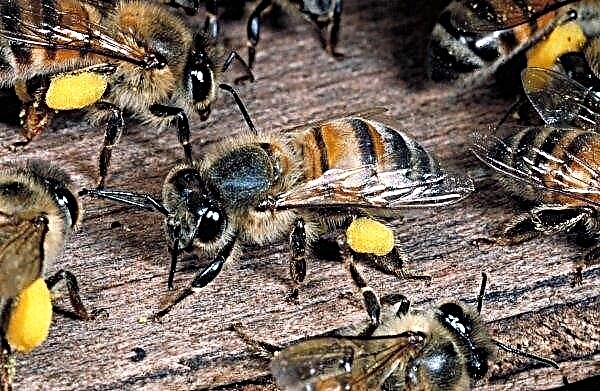Those who grow fish know that you can get a productive livestock of large individuals only in a healthy reservoir. In their blood there are various salts and compounds. And if the external liquid medium is different from the internal, then the body is constantly fighting to maintain the acid-base balance in the norm - this depletes the fish and leads to a decrease in productivity. Liming the pond will help to avoid this. Read more about how much lime needs to be brought into the pond and why to do it, read further in the material.
Functions of Lime in a Pond
There are three main reasons for treating ponds with lime:
- increased nutrient availability;
- increase the pH level and minimize its fluctuations;
- sterilization of a reservoir before wintering.
 Nutrients are phosphorus, and its consumer is phytoplankton, which fish eat.
Nutrients are phosphorus, and its consumer is phytoplankton, which fish eat.
Phosphorus is needed for the growth of phytoplankton, but its level will depend on the type of soil. In freshwater reservoirs it is not so much, and it becomes even less available in acidic water. The use of limestone (calcite or dolomite) increases the pH of water and soil with the simultaneous release of phosphorus.
The acidity of the aquatic environment in the range from 6 to 7 is optimal for the development of most freshwater fish. If the pond is built on acidic soil, then the alkali content in it will be low. By adding lime, you increase overall alkalinity and overall stiffness. For the same purpose, calcite (calcium carbonate) or dolomite (calcium and magnesium carbonate) is used.
Did you know? When heated to its melting point, slaked lime emits bright light. This effect was used in theatrical productions until the 19th century, when new sources of bright lighting appeared.
Aquatic plants also affect the ability of the pond to withstand daily variations in acidity, releasing carbon dioxide as a respiratory product. It acts as an acid and lowers acidity, accumulating at night. During photosynthesis, gas is consumed during the day, and then the level of general alkalinity normalizes.
Sterilization of the pond is also carried out before replenishing it with water. In the process of processing the pond with lime, the pH of sludge and water rises sharply, pathogens and pests that fall into the reservoir are destroyed. This type of cleaning is fatal for fish, therefore it is carried out only in a pond without animals.
 The consumption rate of lime is about 250–270 kg / ha of a reservoir.
The consumption rate of lime is about 250–270 kg / ha of a reservoir.
It must be borne in mind that the need for liming depends on:
- nature of soil - more lime needs to be added to clay than to sand;
- soil pH;
- total alkalinity of water - soft water requires more lime than hard;
- sludge layer thickness at the bottom - for a thickness of 30–40 cm, more lime is needed than for a layer of 5–10 cm;
- pond age - The new pond needs more active substance than the old.
Application Rate
Natural deposits rich in calcium carbonate are limestone. It consists of shells found in abundance in the natural environment. If there is a deposit near you, then use only such limestone, the color of which is in the range from white to light brown.
To produce lime, limestone is exposed to heat. The presence of clay in the feedstock makes the resulting material lumpy. In the process of using it will show low results. It is also known that the effectiveness of calcareous compounds increases with a decrease in their size, so before use, make sure that the substances are well crushed by passing them through a sieve with a mesh size of 0.25 mm.

Thus, for liming reservoirs apply:
| Name of substance | Chemical formula | Synonym name |
| calcium carbonate | CaCO3 | limestone |
| calcium hydroxide | Ca (OH) 2 | hydrated (slaked) lime |
| calcium oxide | Cao | quicklime |
These substances are not equal to each other. So, 1 kg of quicklime is 1.3 kg of quicklime, and if you have limestone, then 1.8 kg will be needed. In addition, you need to measure the general alkalinity of the reservoir and find out how much active substance you need to make.
Two chemicals are needed to determine alkalinity:
- 0.1% hydrochloric acid (HCl) solution;
- a little solution of methyl orange indicator.
The experiment is carried out as follows:
- Take 100 ml of water for testing.
- Add three drops of methyl orange solution to stain the liquid yellow.
- Using a graduated pipette filled with HCl solution, slowly add it dropwise while mixing the sample thoroughly until the yellow color turns orange-yellow.
- Add one more drop: the orange-yellow tint should now turn orange-pink.
- Measure how many milliliters of HCl solution was used - for example, A ml.
Important! When applying hydrated lime, exercise extreme caution and avoid contact with skin, eyes, or inhalation of dust.
If A = 2.5 ml, then the total alkalinity of water is 2.5 (SBV) or equivalent to 2.5 × 50 = 125 mg / L CaCO3 (calcium carbonate). The most efficient fish production is obtained in waters, where the total alkalinity ranges from 75 to 175 mg / l CaCO3.
Consequently, the reservoir from which the water was tested, does not need to be liming. If the total alkalinity is less than 25 mg / l CaCO3, the need for liming is justified. The level of acidity of water can also determine the need for liming.

It must be remembered that:
| At pH less than 5.5 | Lime must be |
| pH 5.5 to 6.5 | This is a good indicator, sufficient for the normal functioning of organisms. |
| pH 6.5 to 8.5 | In this situation, you need to increase pH and alkalinity. |
| pH over 8.5 | Need to increase alkalinity |
Important! Acidity above 7.5 at the bottom soil means that the exchange of water in the pond is too fast and needs to be slowed down.
Liming standards (kg / ha):
| Soil acidity level | Limestone | Hydrated lime | Quicklime |
| 4 | 36 | 26 | 20 |
| 4,5 | 27 | 19,5 | 15 |
| 5 | 18 | 13 | 10 |
| 5,5 | 9 | 6,5 | 5 |
| 6 | 5,4 | 3,5 | 3 |
| 6,5 | 1,8–3,6 | 1,3–2,6 | 1–2 |
Lime Making Methods
Liming methods depend on the type of pond being treated and the purpose. Processing a drained pond is much more effective than a full one. But the water is not drained if there is livestock in the reservoir at the moment, therefore treatment works will become possible only after productive fish are caught.
The primary treatment of a new reservoir occurs as follows:
Check also

- Drain the pond using a submersible pump.
- Distribute limestone from 2,000 kg / ha (sandy soil) to 4,000 kg / ha (clay soil) on a dry day, or use an equivalent amount of another type of lime.
- Fill the pond with water.
- After 1-2 months, check the total alkalinity - if it exceeds 25 mg / l, then nothing else needs to be done, and if it is less than 25 mg / l, then add another 2000 kg / ha of limestone to the water.
- After a month, check the indicator again - if it is still less than 25 mg / l, then add the third dose, and then check again after 30 days. Stop when the desired level is reached.
For medicinal purposes, an annual treatment of the drained bottom is carried out. For this, 1/4 of the total amount of calcareous material necessary for the complete processing of a new pond is added.
Monthly, you need to check the pH level of water at the end of the day. If it is lower than 6.5, then pour from 150 to 200 kg / ha of limestone and check the indicator after a week. If it is still below 6.5, then the algorithm is repeated until the correct values are reached. For a pH of 6.5 to 8.5, one dose (150-200 kg / ha) of limestone can be added to the water. At higher rates, no action is required.
 To distribute the calcareous material evenly, it is added by diluting with water.
To distribute the calcareous material evenly, it is added by diluting with water.
In temperate climates, a drainage or slop pond may be liming in the fall. Quicklime or slaked lime spreads along the wet bottom. If you need to make fertilizers for aquatic plants, then do it in the spring. Ponds for fry are also known in the spring. And fertilizers for water plants are applied 30 days after that.
Pond disinfection with lime
Disinfection is used as a tool for treating diseases of pond animals. So you can not only bleed the existing pathogens, but also implement prevention. The amount of lime applied and the frequency of application depend on the type of disease that is being treated. The basic principle of disinfection is to apply the treatment in a concentration sufficient to destroy the pathogen.
Did you know? It was believed that lime accelerates the decomposition of soft tissues, so in the Middle Ages the bodies of plague victims were buried in quicklime.
Before starting work, all aquatic animals (both dead and living) must be removed from the pond. It should be borne in mind that after the reservoir is cleaned, the placement of potentially infected fish in it will lead to re-infection.
The disinfection procedure consists of the following steps:
- deep cleaning of the bed from the remnants of organic matter;
- disinfection;
- rinsing.
 Quicklime for this will need 25–30 c / ha. It is evenly distributed along the bottom.
Quicklime for this will need 25–30 c / ha. It is evenly distributed along the bottom.
Is it possible to swim in the pond after liming
Liming does not affect the ability to swim in the pond. Unlike fish, people do not need to adapt the acidity of their body to the environment, so you can swim in such water.
Thus, it is recommended to conduct a regular examination of the level of acidity and, if necessary, correct it - this will help the fish stay healthy and gain good weight. And do not forget that lime must be applied strictly in accordance with the norms.

